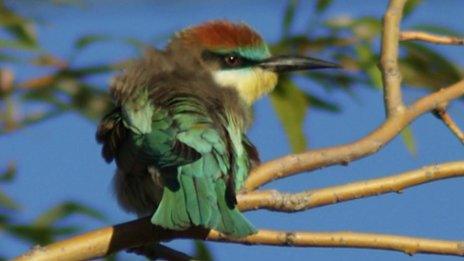Bee-eater is second 'rare' bird spotted in Sunderland
- Published

Bee-eaters hit and rub bees and wasps against a hard surface to remove their stings before they eat them
A second bird rarely seen in the north-east of England has appeared in Sunderland.
The bee-eater, commonly found in North Africa and southern Europe, has taken up residence at a house in Fulwell.
Bird watcher Paul Cook said seeing the bird in the area in November was "incredible".
This week a Little Bunting was also spotted in Elba Park on the outskirts of the city, believed to have been blown off course during migration.
The bee-eater appears to be feeding on a wasps' nest in the eaves of a house belonging to Kirk Adamson.
"I did see it about two weeks ago and I thought it was a kingfisher," he said.
'Very, very lost'
"All these people arrived one morning. I asked one of them what it was and they told me it was a very rare bird and they've been multiplying ever since, the people coming round."
John Taylor, from Consett, is among enthusiasts who have come with cameras after word spread the bird was on Wearside.
Describing himself as a photographer not a twitcher, he said: "We're looking for good quality photographs to enter competitions. We're not really looking just to see the bird."
Mr Cook said it was "remarkable" to see the bee-eater in Sunderland.
"That's why there are so many people from round the country who will have seen bee-eaters before but certainly not in November."
He believes the bird might have been blown off course by recent strong winds in the same way as the Little Bunting.
They were "very, very lost", he said.
- Published7 November 2012
- Published30 October 2012